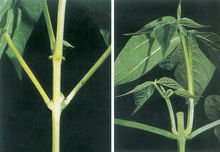The role of IAA 3-indole acetic acid
Used as a plant growth stimulant and analytical reagent. IAA 3-indole acetic acid and other auxin substances such as 3-indoleacetaldehyde, IAA 3-indole acetic acid and ascorbic acid exist naturally in nature. The precursor of 3-indoleacetic acid for biosynthesis in plants is tryptophan. The fundamental function of auxin lies in regulating the growth of plants. It not only promotes growth but also has the effect of inhibiting growth and organ formation. Auxin not only exists in a free state within plant cells, but also can be firmly bound to biological macromolecules and other types of auxin. There are also auxin that can form complexes with special substances, such as indole-acetylasparagine, indole-acetyl pentose acetate and indole-acetylglucose, etc. This might be a form of auxin storage within cells and also a detoxification method to eliminate the toxicity of excessive auxin.
At the cellular level, auxin can stimulate the division of cambium cells; Stimulate the elongation of branch cells and inhibit the growth of root cells; Promote the differentiation of xylem and phloem cells, facilitate the rooting of cuttings, and regulate the morphogenesis of callus.
Auxin plays a role from seedling to fruit maturity at both the organ and whole-plant levels. Reversible red light inhibition of auxin in controlling mesocotyl elongation in seedlings; When indoleacetic acid transfers to the lower side of the branch, the geotropy of the branch occurs. When indoleacetic acid is transferred to the shaded side of the branch, the phototropism of the branch occurs. Indoleacetic acid causes top dominance; Delay leaf senescence; Auxin applied to the leaves inhibits shedding, while auxin applied to the proximal end of the dissociated layer promotes shedding. Auxin promotes flowering, induces the development of unisexual fruits, and delays fruit ripening.
The usage method of IAA 3-indole acetic acid
1. Soaking
(1) During the full flowering period of tomatoes, the flowers are soaked in a solution of 3000 milligrams per liter to induce parthenogenic fruiting and fruit setting of tomatoes, forming seedless tomato fruits and increasing the fruit setting rate.
(2) Root soaking promotes the rooting of crops such as apples, peaches, pears, citrus fruits, grapes, kiwis, strawberries, poinsythia, carnations, chrysanthemums, roses, magnolias, rhododendrons, tea plants, metasequoia glyptostroboides, and poplar, and induces the formation of advadvtive roots, accelerating the rate of vegetative reproduction. Generally, 100-1000mg/L is used to soak the base of cuttings. For varieties that are prone to rooting, a lower concentration is used. For species that are not easy to root, use a slightly higher concentration. The soaking time is approximately 8 to 24 hours, with a high concentration and a short soaking time.
2. Spraying
For chrysanthemums (under a 9-hour light cycle), spraying a solution of 25-400mg/L once can inhibit the appearance of flower buds and delay flowering.
Post time: Jul-07-2025




